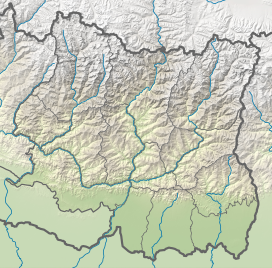
Lhotse
Eight-thousander and 4th-highest mountain on Earth, located in Nepal and China / From Wikipedia, the free encyclopedia
Dear Wikiwand AI, let's keep it short by simply answering these key questions:
Can you list the top facts and stats about Lhotse?
Summarize this article for a 10 years old
Lhotse (Nepali: ल्होत्से L'hōtsē Nepali pronunciation: [lot.se]; Tibetan: ལྷོ་རྩེ Tibetan pronunciation: [l̥otse], lho tse, Chinese: 洛子峰) is the fourth highest mountain in the world at 8,516 metres (27,940 ft), after Mount Everest, K2, and Kangchenjunga. The main summit is on the border between Tibet Autonomous Region of China and the Khumbu region of Nepal.
| Lhotse | |
|---|---|
 The South Face of Lhotse as seen from the climb up to Chukhung Ri | |
| Highest point | |
| Elevation | 8,516 m (27,940 ft)[nb 1] Ranked 4th |
| Prominence | 610 m (2,000 ft)[1] |
| Isolation | 2.66 km (1.65 mi) |
| Listing | Eight-thousander |
| Coordinates | 27°57′42″N 86°56′00″E[1] |
| Geography | |
Solukhumbu District, Sagarmatha Zone, Nepal Show map of Koshi ProvinceTingri County, Shigatse Prefecture, Tibet Autonomous Region, China | |
| Parent range | Mahalangur Himal, Himalayas |
| Climbing | |
| First ascent | 18 May 1956 Fritz Luchsinger, Ernst Reiss (First winter ascent 31 December 1988 Krzysztof Wielicki) |
| Easiest route | glacier/snow/ice climb |
 | |
| Lhotse | |||
|---|---|---|---|
| Traditional Chinese | 洛子峰 | ||
| Simplified Chinese | 洛子峰 | ||
| |||

With Everest to the north and Nuptse to the west, Lhotse forms the apex of the massive horseshoe-shaped arc of the Everest massif. Despite the tremendous vertical relief of its South and Northeast Faces, it is the least prominent of the eight-thousanders due to the great height of the South Col between it and Everest. Lhotse's Western Face, recessed behind the head of the Khumbu Glacier in the Western Cwm, plays an integral part in the standard routes of ascent for both peaks; the name Lhotse, which means "South Peak" in Tibetan, further emphasizes the close relationship between the two.
The main ridge of the mountain features four distinct summits: Lhotse Main at 8,516 metres (27,940 ft) above sea level, Lhotse Middle (also known as Lhotse Central I or Lhotse East) at 8,414 m (27,605 ft), Lhotse Central II at 8,372 m (27,467 ft) and Lhotse Shar at 8,383 m (27,503 ft). Though Lhotse Main is considered to be an intermediately difficult eight-thousander when ascended from the standard Reiss Couloir route, its secondary summits and extremely steep South Face are regarded as some of the most difficult and dangerous climbs in the world.[2][3]


